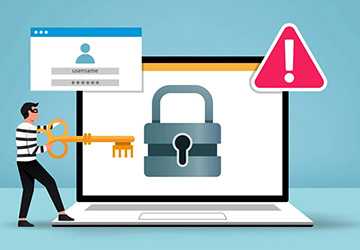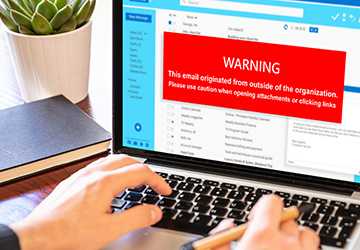How to Secure Your Online Accounts
Alarming. Every click, cookie, and online service leaves a trail of accounts, often with weak defences protecting your crucial data. Account takeovers (ATOs), where cybercriminals hijack your accounts, are a significant threat. And get this - 17% of cyberattacks target vulnerabilities in web applications! That means nearly one in five attacks exploit weaknesses in the sites we trust with our information.

But don't panic! This isn't a dead end. It's a call to action. This blog will equip you with the knowledge to secure online accounts and turn them from vulnerable targets into impenetrable fortresses.
Building a Strong Foundation
Password Power
Let's face it: Passwords are often our online accounts' first line of defence. Yet 53% of users last updated theirs a year ago! Even worse, 57% write them down, and 62% share them electronically. These statistics clearly show that our passwords are a significant security weakness.
Here's why strong, unique passwords are crucial:
● Think of passwords as digital locks. A weak password is like a flimsy padlock—easily broken. Strong passwords are complex combinations that take significant time and effort to crack.
● Uniqueness is key. Sometimes, we need to catch up, and instead of coming up with new passwords, we reuse the same passwords for all accounts. If one gets compromised, all your accounts become vulnerable.
Now, how do we create these robust passwords? Here's your recipe for success:
● Length matters. Aim for at least 12 characters, but longer is even better.
● Complexity is king. Use a mix of letters, symbols, and special characters to create something unique.
● Ditch the dictionary and personal details. Avoid using words easily found in a dictionary or your personal information (birthdays, pet names).
Two-factor Authentication (2FA)
2FA is a security process that requires two distinct forms of identification to verify your identity when logging into an account. This extra step adds a robust layer of security, ensuring that even if your password is compromised, unauthorized access is still blocked.
How 2FA Works
- Something You Know: This is your password, the first factor. It's the information you usually enter to access your account.
- Something You Have or Are: This is the second factor, which can be a code sent to your phone, a fingerprint, or a hardware token.
Beyond the Basics: Advanced Security Measures
We've covered the essential practices for securing online accounts. But for those who crave an extra layer of protection or deal with susceptible information, there are advanced security measures you can take.
Secure Browsing
Now that your accounts have strong passwords and two-factor authentication, let's focus on the digital environment you use to access them.
1. Software Updates
Software updates are like patches for your online armour. They fix vulnerabilities that hackers might exploit. Here's the drill:
● Update your web browser regularly. Most browsers will prompt you when an update is available. Don't postpone it – install the update as soon as possible.
● Keep your operating system and other software up to date. Enable automatic updates whenever possible, or check your software settings regularly for updates.
2. Antivirus and Anti-Malware
Antivirus and anti-malware software constantly scan your computer for suspicious characters.
● Install a reputable antivirus and anti-malware program. Look for a program with a strong reputation and excellent detection rates.
● Schedule regular scans. Don't just install it and forget it! Set your software to scan your computer automatically at least once a week.
3. Scrutinize Links and Attachments
Phishing emails and malicious websites trick you into clicking links or downloading attachments that can infect your device or steal your information. Here's how to stay vigilant:
● Hover over links before clicking. Look for suspicious website addresses in the bottom corner of your browser window before you click on a link.

● Don't download attachments from unknown senders. Even if the email appears from someone you know, be cautious if you weren't expecting an attachment.
● When in doubt, throw it out. If you're unsure about a link or attachment, err on caution and delete it.
Social Media Savvy
Social media is a fantastic way to connect, but being mindful of your security is essential. Follow these online security tips to become a social media whiz who prioritizes privacy:
1. Privacy Settings
Every social media platform has privacy settings that let you control who sees your information and activity. Here's what to do:
● Review and adjust your privacy settings regularly. Don't settle for the defaults! Look for options like:
● Who can see your posts (public, friends only, etc.)
● What information is displayed on your profile (limit birthday, address, etc., if desired)
● Make separate accounts for personal and professional use (optional, but can give you more control).
2. Think Before You Share
Social media is a public space, even with privacy settings. Here's how to be mindful:
● Avoid sharing personal details publicly, such as your address, phone number, birthday, or anything that could be used for identity theft.
● Be cautious about location sharing. Think twice before enabling location tagging on posts, especially if they reveal your home or workplace.
● Practice delayed gratification. Don't post impulsively about vacations, expensive purchases, or anything that could make you a target.
3. Suspicious Strangers
Only some people online have good intentions. Here's how to stay safe:
● Don't accept friend requests from people you don't know.
● Be wary of messages from strangers. Don't click on links or attachments in unsolicited messages.
● Report suspicious activity to the platform. If someone is harassing you or sending strange messages, report them to the social media website or app.
Use Encrypted Connections
When you access websites or online accounts, the information travels like a package. Here's how to make sure those packages are delivered securely:
1. HTTPS
HTTPS (Hypertext Transfer Protocol Secure) encrypts the information you send and receive online and turns it into an unreadable format for anyone who might intercept it. Here's how to spot secure connections:
● Look for "HTTPS" at the beginning of the website address (URL). You will likely see a small padlock icon in your address bar, which indicates that the browser is secure.
● Make HTTPS a habit. Don't just rely on the padlock—check for HTTPS before entering sensitive information on a website.
2. VPN
Public Wi-Fi networks, like those in coffee shops or airports, can be convenient, but they're only sometimes secure. A Virtual Private Network (VPN) encrypts all your internet traffic, creating a secure tunnel between your device and the internet. Here's when a VPN is essential:
● Use a VPN whenever you're on public Wi-Fi. This is especially important if you're accessing online accounts like banking or email.
● Consider using a VPN for added security, even on private networks. While it's not always necessary, a VPN can help shield your online activity from the wrong eyes.
Conclusion
Following the steps outlined above, you can significantly improve your online security posture and protect online accounts from unauthorized access. Remember, online security is an ongoing process. New threats always emerge, so staying vigilant and having solid defences is essential.